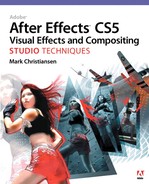Acknowledgments
When I started the first edition of this book, I may have guessed there was a chance it would be a success and find its way into multiple editions, but I certainly wasn’t focused on that. Some fundamental things about the book, like its basic structure, have not changed, but other aspects have been radically revamped for this one.
That parallels the development of After Effects itself. I can still vividly remember the excitement of getting started creating shots in After Effects before I even had heard the term “compositor,” and fooling a renowned visual effects veteran—a veteran, who shall remain nameless, who had no idea the tools existed on the desktop to do this kind of stuff. After Effects is compelling enough on its own to make it worth becoming an expert.
Thank you in particular to Adobe for loaning the time and energy of Todd Kopriva to work on this edition. Todd doesn’t let you get away with anything and, as Michael Coleman said to me, he represents the “gold standard” for technical editorial work. I can’t imagine a better person for that role on this edition of the book.
It can be difficult to properly acknowledge the deceased. When the last version of this book came out, The Orphanage, the facility where my After Effects chops found a setting in which we could push compositing in this software to the maximum, was still very much alive. I remain grateful to filmmaker Stu Maschwitz, who cofounded and was CTO of The Orphanage, for helping to guide the first edition to truly reflect best practices in VFX and help set a standard for this book.
Maintaining that standard has been possible only with the collaboration of others. In the last edition, I brought in the best guy I knew to explain expressions, Dan Ebberts, and a counterpart on the scripting side, Jeff Almasol, to contribute chapters on their respective specialties, and those remain in this edition.
But there have been other, perhaps less likely contributors to the book and disc you have before you. It was a challenge from a reader, a filmmaker in Switzerland named Sergio Villalpando, that caused me to completely redo a chapter that I had considered the heart of the book (Chapter 6: Color Keying). He encountered difficulty putting the techniques described into practice, and the way in which he articulated his frustration was clear and concise enough to motivate me to approach it as if starting over, basing the new version much more closely on a step-by-step example.
My students at Academy of Art made me realize that—although it’s great to impress everyone with a mind-blowingly clever technique—clear, patient elucidation of fundamentals is far more valuable. The personal experience of using the previous edition of the book to teach this material led to many changes in this edition, including the addition of a simple example comp in the very first chapter. Students have a better understanding of this process before even beginning it these days, and even though this is not a beginner book, the patient novice may now find an easier way in, thanks to my classroom experience.
Collaboration is key to this work. In gathering new material for this edition I had a few collaborators who were willing to shoot material, either with me on a day out (thanks Tyler McPherron) or remotely (gratitude to Chris Meyer—yes, that Chris Meyer—and to Eric Escobar). Brendan Bolles provided a wonderful description of the difference between low and high dynamic range imaging, which remains lucid and lively enough that I’ve left a lot of it intact in Chapter 11.
More and other contributors have been essential to past, current, and future book editions including Kontent, Pixel Corps, Artbeats, fxphd, Case Films, Creative COW, Ken-wood Group, Inhance, Sony, ABC, Red Bull USA, and individuals such as Pete O’Connell, Benjamin Morgan, Matt Ward, Ross Webb, Luis Bustamente, Micah Parker, Jorge L. Peschiera, Shuets Udono, Eric E. Yang, and Kevin Miller.
This book’s cover was designed by Regina Cleveland with the guidance of Charlene Will. Thanks to both of you for taking a bunch of ideas I put out there, from the ridiculous to the even more ridiculous, and coming up with a design that feels fresh and lively without causing any corporate powers-that-be to collapse.
It’s the people at Adobe who’ve made After Effects what it is, in particular Dave Simons and Dan Wilk, as well as Michael Natkin, Chris Prosser, John Nelson, Ellen Wixted, and Michael Coleman plus the many—but not as many as you might think—other members of the development team.
Thanks to the companies whose tools are included on the book’s DVD: Jack Binks at The Foundry, Peder Norrby, who is Trapcode, Russ Andersson of Andersson Technologies, Sean Safreed of Red Giant Software, Andrew Millin of ObviousFX LLC, Marco Paolini of SilhouetteFX, Pierre Jasmin and Pete Litwinowicz of RevisionFX, Robert Sharp and the whole crew at Digieffects, and Philipp Spoth of Frischluft. Why bother discussing tools that aren’t worth using, when there are great ones like these?
This is the best edition yet of this book thanks to the efforts and commitment of the many good people at Peachpit, all of whose best qualities are embodied in one Karyn Johnson. Without you, the pieces would not have come together in the way they did, the book would not be written the same, and the entire process would have been a whole lot less fun. Your humor, patience, commitment, and professionalism make this process of publishing a book relevant and vital, and you are truly able to bring out the best in others.
Finally, thank you to you, the people who read, teach, and respond to the material in this book. Your comments and questions are welcome at [email protected].
